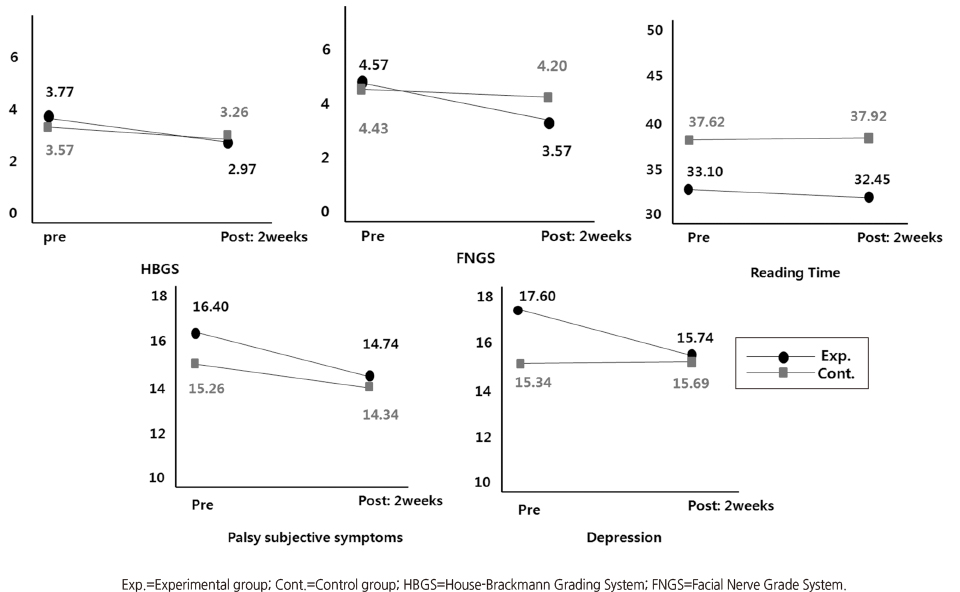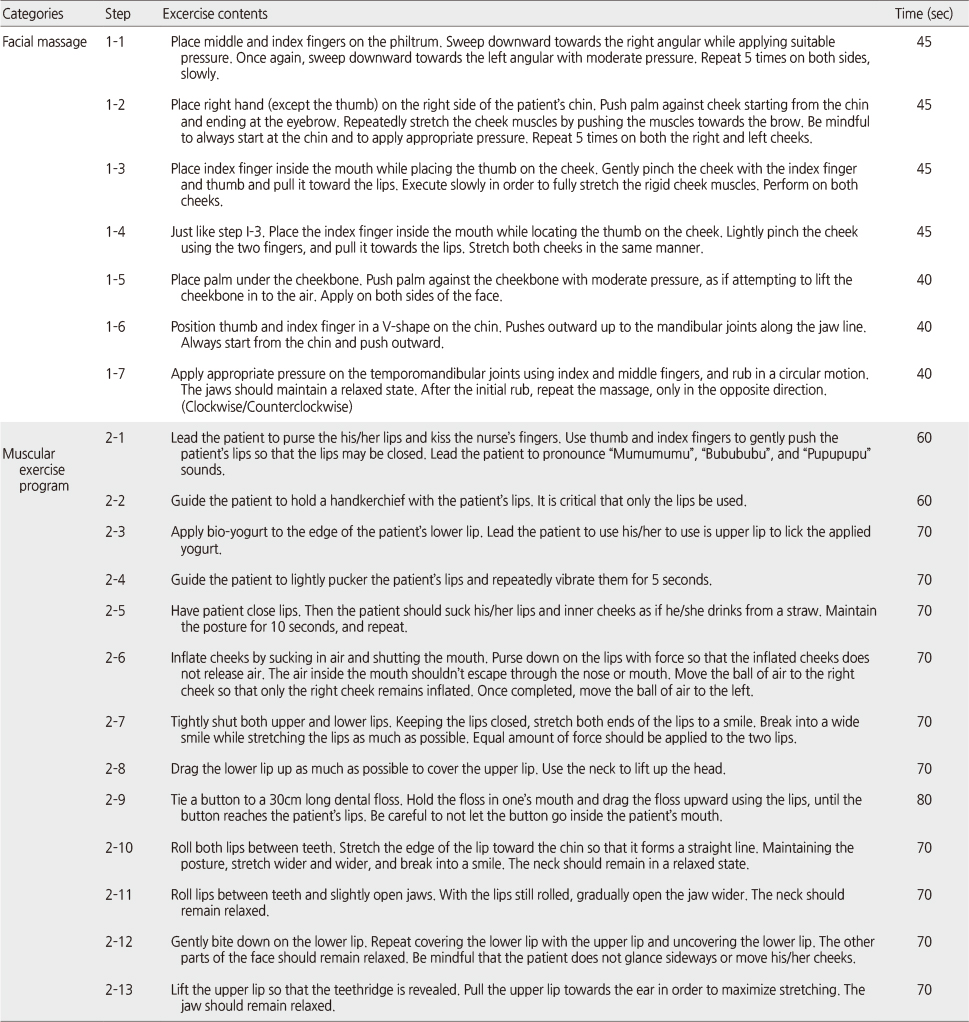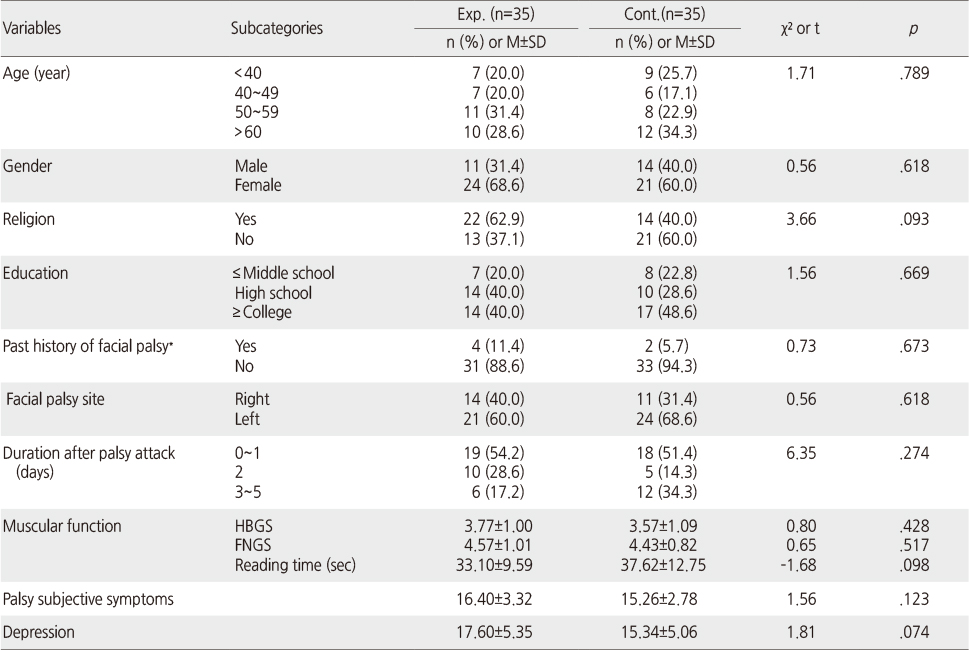Articles
- Page Path
- HOME > J Korean Acad Nurs > Volume 46(4); 2016 > Article
-
Original Article
- Effects of a Facial Muscle Exercise Program including Facial Massage for Patients with Facial Palsy
- Hyoung Ju Choi, Sung Hee Shin
-
Journal of Korean Academy of Nursing 2016;46(4):542-551.
DOI: https://doi.org/10.4040/jkan.2016.46.4.542
Published online: August 31, 2016
1Department of Nursing, Kyung Hee University Hospital at Gangdong, Seoul, Korea.
2College of Nursing Science and East-West Nursing Research Institute, Kyung Hee University, Seoul, Korea.
- Address reprint requests to: Shin, Sung Hee. College of Nursing Science and East-West Nursing Research Institute, Kyung Hee University, 26, Kyungheedae-ro, Dongdaemun-gu, Seoul 02447, Korea. Tel: +82-2-961-0917, Fax: +82-2-961-9398, sunghshin@khu.ac.kr
© 2016 Korean Society of Nursing Science
This is an Open Access article distributed under the terms of the Creative Commons Attribution NoDerivs License. (http://creativecommons.org/licenses/by-nd/4.0/) If the original work is properly cited and retained without any modification or reproduction, it can be used and re-distributed in any format and medium.
Abstract
-
Purpose
- The purpose of this study was to examine the effects of a facial muscle exercise program including facial massage on the facial muscle function, subjective symptoms related to paralysis and depression in patients with facial palsy.
-
Methods
- This study was a quasi-experimental research with a non-equivalent control group non-synchronized design. Participants were 70 patients with facial palsy (experimental group 35, control group 35). For the experimental group, the facial muscular exercise program including facial massage was performed 20 minutes a day, 3 times a week for two weeks. Data were analyzed using descriptive statistics, χ2-test, Fisher's exact test and independent sample t-test with the SPSS 18.0 program.
-
Results
- Facial muscular function of the experimental group improved significantly compared to the control group. There was no significant difference in symptoms related to paralysis between the experimental group and control group. The level of depression in the experimental group was significantly lower than the control group.
-
Conclusion
- Results suggest that a facial muscle exercise program including facial massage is an effective nursing intervention to improve facial muscle function and decrease depression in patients with facial palsy.
This article is based on a part of the first author's master's thesis from Kyung Hee University.
The authors declared no conflict of interest.
- 1. Korean Society of Otorhinolaryngology-Head and Neck Surgery. Otorhinolaryngology. Seoul: Ilchokak; 2005. p. 1–631.
- 2. National Health Insurance Service. Facial nerve palsy patient[Internet]. Seoul, Author. 2013;cited 2016 January 10. Available from: http://www.nhis.or.kr/bbs7/boards/B0039/2966
- 3. Choi SW, Yook TH, Song BY. A clinical study about factors to have an influence on the prognosis of Bell's palsy. J Korean Acupunct Moxibustion Soc. 2004;21(3):43–59.
- 4. Min YK, Ahn CB, Jang KJ, Yoon HM, Kim CH, Song CH, et al. An analysis of clinical prognosis factors of Bell's palsy. J Korean Acupunct Moxibustion Soc. 2008;25(3):163–177.
- 5. Kwon HY, Cho TS, Son IS, Youn HM, Seo JC, Jang KJ, et al. The evaluation of improvement of Bell's palsy by Yanagihara's system. J Korean Acupunct Moxibustion Soc. 2002;19(1):118–126.
- 6. Koo GH. Facial nerve palsy. J Korean Pain Soc. 1996;9(1):14–25.
- 7. Hwang YJ. The effects of massage and oro-facial exercise program (MOEP) on spastic dysarthric's lip muscle function[master's thesis]. Daegu, Taegu University. 2004;1–104.
- 8. Kang BM, Kwon HC, Kim H, Cho YN. Effect of orofacial exercise on the swallowing function of stroke patients. J Korean Acad Occup Ther. 2013;21(3):57–69.
- 9. Seo JE, Jeon BU. The effect of respiration and oral motor training on correctness of consonants and the vocalization prolongation, for children with spastic cerebral palsy. Educ J Phys Mult Disabl. 2007;49:135–160.Article
- 10. Hardy E, Robinson NM. Swallowing disorders treatment manual. 2nd ed. Austin, TX: Pro-ed; 2004.
- 11. Park KS, Lee MH, Kang SK. The influence of skin temperature's change in manipulative therapy. J Korean Soc Cosmetol. 2006;12(3):120–125.
- 12. Lee JS, Seo NS, Han MS. Effects of meridian massage on facial paralysis, pain, and anxiety in Bell's palsy patients. J East West Nurs Res. 2009;15(2):110–118.
- 13. Lee J. The effect of acupressure massage on the change of digital infrared thermologic imaging, facial paralysis status, subjective symptoms, and depression in Bell's palsy patients[dissertation]. Naju, Dongshin University. 2010;1–80.
- 14. Ahn KM, Hong KH, Lee JS, Shin KO. A study on regulation of sebum·moisture, elasticity and edema in face by combination of manual & jade massage. J Cosmetol Sci. 2010;6(4):337–346. Article
- 15. Lee YW, Jeong JY, Kim HJ, Shin YS. Changes of infrared thermographic findings in bilateral Bell's palsy treated with stellate ganglion block. J Korean Pain Soc. 2001;14(1):93–97.
- 16. House JW, Brackmann DE. Facial nerve grading system. Otolaryngol Head Neck Surg. 1985;93(2):146–147.ArticlePubMedPDF
- 17. Kim MB, Kim JH, Shin SH, Yoon HJ, Ko WS. A study of facial nerve grading system. J Korean Orient Med Ophthalmol Otolaryngol Dermatol. 2007;20(3):147–160.
- 18. Lee OB, Kwon DH. The effects of the articulatory training program on the dysarthric speech in subjects with dysarthria. J Speech Hear Disord. 1998;7(2):131–152.
- 19. Lee CW, Park IB, Kim SW, Kim HG, Heo SW, Kim CH, et al. The effect of acupuncture and Dong's acupuncture about Bell' palsy. J Korean Acupunct Moxibustion Soc. 2004;21(2):287–300.
- 20. Radloff LS. The CES-D scale: A self-report depression scale for research in the general population. Appl Psychol Meas. 1977;1(3):385–401.
- 21. Cho MJ, Kim KH. Diagnostic validity of the CES-D (Korean version) in the assessment of DSM-III-R major depression. J Korean Neuropsychiatr Assoc. 1993;32(3):381–399.
- 22. Gongole DC. The Source for oral-facial exercises: Updated and expanded. East Moline, IL: LinguiSystems; 1993.
- 23. Kim WH, Park EY, Chang KY, Lee YJ. Effect of electromyographic biofeedback training on the muscle activities of unilateral facial palsy. Phys Ther Korea. 2002;9(3):101–112.
- 24. Kim EM, Jung HM. The effect of facial meridian massage on facial paralysis status, pain and stress of Bell’s palsy patients. Clin Nurs Res. 2006;11(2):135–147.
- 25. Lee HY, Kim BE. The effect of meridian points massage nursing intervention on the recovery of facial paralysis. J Korean Acad Nurs. 2001;31(6):1044–1054.ArticlePDF
- 26. Kang YR. A study on self-consciousness and coping method for middle-aged housewives, stress based on exercise[master's thesis]. Seoul, Ewha Woman University. 1997;1–72.
- 27. Marra CM. Bell's palsy and HSV-1 infection. Muscle Nerve. 1999;22(11):1476–1478. ArticlePubMed
- 28. Yu JH. The effect of exercise program to ease the musculoskeketal symptoms among the people working in a hotel. Korean J Occup Health Nurs. 2008;17(2):138–145.
- 29. Kim ES, Lee SH, Nam SS, Kim YS. A study of psychological distress, anxiety and depression on motor recovery of acute Bell's palsy patients' facial muscle. The Acupuncture. 2014;31(1):149–158. Article
REFERENCES
Figure & Data
REFERENCES
Citations

- Integrated HRI and lean digital healthcare approach for facial paralysis rehabilitation via exoskeletons and smartphone applications
Mingxuan Wang, Luyi Xin, Zhaopeng Zhu, Tong Wu, Hao Chen, Ting Han
Industrial Management & Data Systems.2025;[Epub] CrossRef - Effect of modified facial paralysis rehabilitation nursing on patients with facial paralysis after vestibular schwannoma surgery
Wei Fu, Jiantao Liang, Mingchu Li, Gang Song, Jing Guo, Hongyu Zheng, Xiaolei Zhang
Heliyon.2024; 10(15): e35060. CrossRef - A Pilot Survey Examining Satisfaction for Integrated Medicine Based on Critical Pathways for Acute Facial Palsy
Min-Jung Ko, Sang-Yeup Chae, Seungeun Lee, Dongmin Lee, Jaeho Song, Jinkyung Park, Jung-Hyun Kim, Bonhyuk Goo, Yeon-Cheol Park, Byung-Kwan Seo, Yong-Hyeon Baek, Sang-Soo Nam
Journal of Acupuncture Research.2023; 40(3): 245. CrossRef - Effectiveness of therapeutic massage for improving motor symptoms in Parkinson's disease: A systematic review and meta-analysis
Zhiran Kang, Hua Xing, Qiang Lin, Fanchao Meng, Li Gong
Frontiers in Neurology.2022;[Epub] CrossRef - Neural mobilization in Bell’s palsy: A case report
Faizan Zaffar Kashoo, Mazen Alqahtani, Mehrunnisha Ahmad
CRANIO®.2021; 39(3): 266. CrossRef - Effects of Facial Muscles Exercise on Mental Health: A Systematic Review
Rumiko Okamoto, Toshie Manabe, Katsuyoshi Mizukami
International Journal of Environmental Research and Public Health.2021; 18(22): 12216. CrossRef - Give me a kiss! An integrative rehabilitative training program with motor imagery and mirror therapy for recovery of facial palsy
Teresa Paolucci, Alessia Cardarola, Paola Colonnelli, Giorgia Ferracuti, Roberta Gonnella, Massimiliano Murgia, Valter Santilli, Marco Paoloni, Andrea Bernetti, Francesco Agostini, Massimiliano Mangone
European Journal of Physical and Rehabilitation Medicine.2020;[Epub] CrossRef - A Facial Chuna Manual Therapy for Peripheral Facial Nerve Palsy
Yu-Kyeong Park, Cho In Lee, Jung Hee Lee, Hyun-Jong Lee, Yun-kyu Lee, Jung-Chul Seo, Jae Soo Kim
Journal of Acupuncture Research.2019; 36(4): 197. CrossRef

Figure 1
Facial Muscular Exercise Program including Facial Massage
Homogeneity Test of Characteristics and Dependent Variables between Experimental and Control Group (N=70)
*Fisher's exact test; Exp.=Experimental group; Cont.=Control group; HBGS=House–Brackmann grading system; FNGS=Facial nerve grade system.
Comparison of Dependent Variables between Two Groups after Treatment (N=70)
Exp.=Experimental group; Cont.=Control group; HBGS=House–Brackmann grading system; FNGS=Facial nerve grade system.
*Fisher's exact test; Exp.=Experimental group; Cont.=Control group; HBGS=House–Brackmann grading system; FNGS=Facial nerve grade system.
Exp.=Experimental group; Cont.=Control group; HBGS=House–Brackmann grading system; FNGS=Facial nerve grade system.
 KSNS
KSNS
 E-SUBMISSION
E-SUBMISSION




 Cite
Cite

